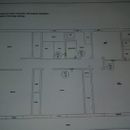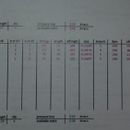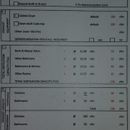HRV help
Hello,
House – 2 story, no basement, 2000 sq feet, 4 bedroom, 2.5 bath, Ductless heat pumps, ACH 1.9, Climate zone 6
I am in the process of planning my HRV retrofit. I have obtained a duct design from a local company and am in the process of getting the equipment so i can install the ductwork and HRV. I just wanted to ask the local community if they feel the design, airflow and equipment suggested make sense before moving ahead and purchasing.
Design airflow 138cfm high, 69 cfm low (I think it was calculated at 0.6 in w.c)
Recommended Equipment – Lifebreath 205 – 179 cfm @ 0.4, 148cfm @ 0.6
Could I use a Vannee 90H-V ECM instead of the recommended lifebreath – 80-157 cfm @ 0.4, 136CFM @ 0.6.
Attached are a few screen grabs from the report that was provided.
Thanks for your thoughts/input
Jeremy
GBA Detail Library
A collection of one thousand construction details organized by climate and house part














Replies
HI Jeremy -
Not my area of expertise I am sorry to say but this comment by me will elevate your question on GBA and the Q&A so hopefully others can comment.
Best - Peter
Jeremy,
I would recommend an ECM motor as they are quieter and use about 1/2 the power, important for something that runs 24/7. The Vanee unit is not that efficient, there are other units out there that have ECM motors and better efficiency (look for units with a hexagonal core).
The duct heater might not be needed if you can get the fresh air outlet in the living are near the inlet of your minisplits. As for the bedrooms, I typically prefer a bit colder air in the bedrooms anyways. If the cost delta is minimal, might as well install it even if it is not used.
Otherwise, it looks like the HVAC folks did a good job designing the setup.
The screen grabs are very hard to make out much detail on. I find it very odd that they have unbalanced supply and exhaust on the one worksheet, but maybe that's just an oddity of the form. You seem to have four bedrooms, but only two of them get a fresh air supply? I don't like that.
Thanks for the bump Peter!
Akos, thanks for your insight, I will definitely look at different models to see if I can get my hands on an efficient one with and ECM. 2 of the supplies will be located close to a miniplit head, the other will be in a room with a woodstove. I will hold off on the pre-heater for now and perhaps add it in later if i feel its needed.
Trevor, thanks for the comment. I agree I wanted to get a supply into the other two bedrooms as well, but as its a retrofit we came up with the best layout we could. To get those two bedrooms i would have a pretty ugly bulkhead in a bad location. I am hoping that the placement of one supply that is in-front of a miniplit head will aid in some circulation to those rooms. If not I am prepared to add a pair of lunos to service those rooms down the road. Not ideal I know, but hopefully close to it
Thanks again for the comments, seems like over all the designer guy did an okay job with regards to the airflows.
Jeremy
I can help you with this. First off, it seems your located in Canada, possibly Ontario? That seems to be an F-326 ventilation report. The airflow rate at 0.6 in.wc. reported on the form is incorrect, as well as the efficiency at 0°C.
HRV ducts should be designed at 0.4" w.c., this is typically the sweet spot for cfm/watt. 0.6 is pretty high. I'd only use that if the ducts had to be kept small for some reason.
If you're going to use the Vanee 90H-V ECM (Which I'd highly recommend, it's a great unit) then you should set it on Speed Range 2 - 65-157 cfm. It will suit your house better.
With the new HRV and lower static pressure available, your outside duct runs need to increase to 7". The exhaust trunk (the one that services the bathrooms and kitchen) that are currently 6" should be upsized to 7" as well. The fresh air trunk should be upsized to 7" from the HRV to F4.
With the Vanee 90H-V ECM, your delivered air temperature at -25°C will be approx. 12°C, so you could probably eliminate the duct heater if you feel that would be an acceptable temperature. If you use wall grilles that aim the air up and out towards the ceiling, it should mix acceptably before reaching inhabitants.
Yupster, thanks for your comments.
Yes i am in Ontario, near Kingston. They must have used that static pressure as I asked for 6 inch trunk lines. As mentioned its a retrofit so i am trying to minimize the size of bulkheads in a few areas. Would the system still work well as is? It would just cost a bit more to operate cfm/watt?
So if i want to use the Vanee I would need to increase to 7 inch from HRV to exhaust/supply hoods to the outside, Use a 7 inch main for the entire exhaust line. Use a 7 inch from hrv to F4, 6" from F4 to F3 and then 5" after that? All 4" lines stay the same? The extra couple inches might not be to bad on the bulkhead ...
Thanks again
If you used the same static pressure (0.6 in.wc.) with the Vanee, your airflow would be reduced by about 10% to 140 cfm. If keeping the ducts small is important, that's perfectly fine, your HRV will just consume more fan energy. You could keep the duct design the same as it is now though.
That's all correct.
Not far from me then. Hello from Havelock, near Peterborough. What HVAC design firm did you use out of curiosity?
Thanks again! I may keep everything as is, but you have given me something to think about as I move forward, thanks!
I actually grew up in Trenton, just south of you, practically neighbors!
I worked with Wolseley when i was getting my heat load calculations done during an energy retrofit. Everything has been working well so i decided to use them as well for my HVR.
Jeremy,
I wouldn't sweat the pipe size too much if you be running the unit mostly at low speed (I mostly use boost for getting the wet dog smell out of the house).
At the low ventilation design flow rate, there won't be much losses with your ducting even if you use a lot of flex to significantly change the CFM/W of the unit.
At high the losses would be more, but if it is only used occasionally won't matter much. My ERV is ducted outside with 4" ducts and I can still get 90CFM on a 100CFM rated unit.
"Not sweating it" is an attitude taken far too often by HRV installers in this area and the results? Poorly functioning HRV systems that are often left unplugged because the homeowner doesn't know what it is, it doesn't seem to be doing anything, and it makes a lot of noise. It certainly doesn't clear their bathroom out fast enough.
Say he doesn't worry about pipe sizes, skimps here, installs a poor choice for a fitting there, installation mistake over there. Ends up with a 25% reduction in performance. A reasonable number from what I've seen from installations. He has a boost button in the bathroom for clearing the air after...stuff. Now he only has 20 cfm availabe instead of 30 cfm. Takes 25 minutes to change the air out of the 500 ft² bathroom once rather than 15 minutes, a 40% increase. It doesn't take a lot to have big impacts.
The performance impacts of duct sizes vary wildly depending on fittings, material, lengths, and terminations. Using undersized ducts might have worked out for you, but that is no indication that it would work for someone else with a different set of circumstances. That's why I advocate (and GBA as well) good duct design and good installation that reflects the design.
I know GBA is the forum where good enough suggestions are frowned upon, we should all strive to do the best design we can. Sometimes, we need to make compromises, making those blind is how you end up with ventilation system that doesn't work. I would never advocate for this.
I'm going by the assumption that since this is a retrofit, the bathrooms already have an exhaust fan, so the main purpose of the HRV is to provide the air exchange in the house. If this is the case, you can make some compromises if it makes the install easier.
At the low setting 69 cfm, there is very little benefit to the extra duct size.
At the design flow, going from 7 to 6 reduces the flow by ~15% (Vanee blower curve), or by turning up the blower a bit, you get the same flow for slightly more power. Based on the earlier assumptions, that is reasonable compromise.
I appreciate all comments regarding my question. The great thing about this site is the mix of individuals with different levels of expertise and ideas. In the end all i can do is make the best plans based on research and the input from people like you who spare the time to comment.
Akos. Considering it is a retrofit its a fair assumption that the bathrooms already had exhaust fans installed. However, i guess the previous owners relied on open windows to clear the air as there is currently no exhaust in any of bathrooms.
Thanks again
Hi again
Any thoughts on using 2 smaller HRV versus 1 larger? Pricing out some equipment and duct material it wouldnt cost me much more but in my situation would save a lot of time running ducts, building bulkheads and finishing work.
You might get a little less efficiency from the two smaller units but really there's nothing wrong with that, as long as it doesn't tempt you to run ducts outside the conditioned envelope. You also get the option of boosting the speed preferentially--every time someone gets a shower in our house, the one big HRV bumps up the exhaust rate from all three bathrooms and the kitchen. It would be nicer to only boost where needed.
Thanks for the feedback Charlie. Your right, the operational cost would go up over all. That is definitely a downside but it would be nice to boost the unit independently when needed. I guess it just seems a little weird to have 2 units but the time and money saved on finish work might make it worth it. Luckily i have to areas on either side of the house i can hide a smaller unit.
Jeremy